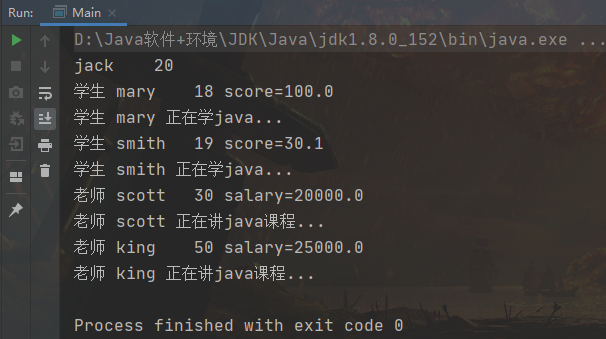数组的定义类型为父类型,里面保存的实际元素类型为子类型。
应用案例:
- 要求创建一个Person对象,2个Student对象和2个Teacher对象,统一放在数组中,并调用每个对象的say方法。
- 如何调用子类特有的方法,比如Teacher有一个teach,Student有一个study,怎么调用?


Person
package test;public class Main { public static void main(String[] args) { //应用实例:现有一个继承结构如下:要求创建1个Person对象、 // 2个Student 对象和2个Teacher对象, 统一放在数组中,并调用每个对象say方法 //父类的引用可以指向子类的对象 Person[] persons = new Person[5]; persons[0] = new Person("jack", 20); persons[1] = new Student("mary", 18, 100); persons[2] = new Student("smith", 19, 30.1); persons[3] = new Teacher("scott", 30, 20000); persons[4] = new Teacher("king", 50, 25000); //循环遍历多态数组,调用say for (int i = 0; i < persons.length; i++) { // person[i] 编译类型是 Person ,运行类型是是根据实际情况由JVM来判断 System.out.println(persons[i].say());//动态绑定机制 //编译类型Person中不含有这两个方法// persons[i].teach();//报错!!!// persons[i].study();//报错!!! //解决方案: 使用 类型判断 + 向下转型. if (persons[i] instanceof Student) {//判断person[i] 的运行类型是不是Student Student student = (Student) persons[i];//向下转型 student.study(); //也可以使用一条语句 ((Student)persons[i]).study(); } else if (persons[i] instanceof Teacher) { Teacher teacher = (Teacher) persons[i]; teacher.teach(); } else if (persons[i] instanceof Person) { //就是Person类型,不做处理 } else { System.out.println("你的类型有误, 请自己检查..."); } } }}
Student
package test;public class Student extends Person { private double score; public Student(String name, int age, double score) { super(name, age); this.score = score; } public double getScore() { return score; } public void setScore(double score) { this.score = score; } //重写父类say @Override public String say() { return "学生 " + super.say() + " score=" + score; } //特有的方法 public void study() { System.out.println("学生 " + getName() + " 正在学java..."); }}
Teacher
package test;public class Teacher extends Person { private double salary; public Teacher(String name, int age, double salary) { super(name, age); this.salary = salary; } public double getSalary() { return salary; } public void setSalary(double salary) { this.salary = salary; } //写重写父类的say方法 @Override public String say() { return "老师 " + super.say() + " salary=" + salary; } //特有方法 public void teach() { System.out.println("老师 " + getName() + " 正在讲java课程..."); }}
Main
package test;public class Main { public static void main(String[] args) { //应用实例:现有一个继承结构如下:要求创建1个Person对象、 // 2个Student 对象和2个Teacher对象, 统一放在数组中,并调用每个对象say方法 //父类的引用可以指向子类的对象 Person[] persons = new Person[5]; persons[0] = new Person("jack", 20); persons[1] = new Student("mary", 18, 100); persons[2] = new Student("smith", 19, 30.1); persons[3] = new Teacher("scott", 30, 20000); persons[4] = new Teacher("king", 50, 25000); //循环遍历多态数组,调用say for (int i = 0; i < persons.length; i++) { // person[i] 编译类型是 Person ,运行类型是是根据实际情况由JVM来判断 System.out.println(persons[i].say());//动态绑定机制 //编译类型Person中不含有这两个方法// persons[i].teach();//报错!!!// persons[i].study();//报错!!! //解决方案: 使用 类型判断 + 向下转型. if (persons[i] instanceof Student) {//判断person[i] 的运行类型是不是Student Student student = (Student) persons[i];//向下转型 student.study(); //也可以使用一条语句 ((Student)persons[i]).study(); } else if (persons[i] instanceof Teacher) { Teacher teacher = (Teacher) persons[i]; teacher.teach(); } else if (persons[i] instanceof Person) { //就是Person类型,不做处理 } else { System.out.println("你的类型有误, 请自己检查..."); } } }}





